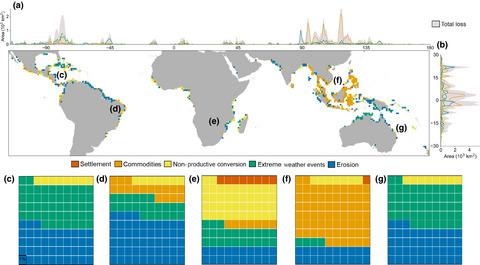当前位置:
X-MOL 学术
›
Glob. Change Biol.
›
论文详情
Our official English website, www.x-mol.net, welcomes your
feedback! (Note: you will need to create a separate account there.)
Global declines in human-driven mangrove loss.
Global Change Biology ( IF 10.8 ) Pub Date : 2020-07-12 , DOI: 10.1111/gcb.15275 Liza Goldberg 1, 2, 3 , David Lagomasino 2, 4 , Nathan Thomas 2, 3 , Temilola Fatoyinbo 2
Global Change Biology ( IF 10.8 ) Pub Date : 2020-07-12 , DOI: 10.1111/gcb.15275 Liza Goldberg 1, 2, 3 , David Lagomasino 2, 4 , Nathan Thomas 2, 3 , Temilola Fatoyinbo 2
Affiliation

|
Global mangrove loss has been attributed primarily to human activity. Anthropogenic loss hotspots across Southeast Asia and around the world have characterized the ecosystem as highly threatened, though natural processes such as erosion can also play a significant role in forest vulnerability. However, the extent of human and natural threats has not been fully quantified at the global scale. Here, using a Random Forest‐based analysis of over one million Landsat images, we present the first 30 m resolution global maps of the drivers of mangrove loss from 2000 to 2016, capturing both human‐driven and natural stressors. We estimate that 62% of global losses between 2000 and 2016 resulted from land‐use change, primarily through conversion to aquaculture and agriculture. Up to 80% of these human‐driven losses occurred within six Southeast Asian nations, reflecting the regional emphasis on enhancing aquaculture for export to support economic development. Both anthropogenic and natural losses declined between 2000 and 2016, though slower declines in natural loss caused an increase in their relative contribution to total global loss area. We attribute the decline in anthropogenic losses to the regionally dependent combination of increased emphasis on conservation efforts and a lack of remaining mangroves viable for conversion. While efforts to restore and protect mangroves appear to be effective over decadal timescales, the emergence of natural drivers of loss presents an immediate challenge for coastal adaptation. We anticipate that our results will inform decision‐making within conservation and restoration initiatives by providing a locally relevant understanding of the causes of mangrove loss.
中文翻译:

全球人为造成的红树林损失减少。
全球红树林消失主要归因于人类活动。东南亚和世界各地的人为损失热点已使生态系统受到高度威胁,尽管侵蚀等自然过程也可能在森林脆弱性中发挥重要作用。然而,人类和自然威胁的程度尚未在全球范围内得到充分量化。在这里,我们使用对超过一百万张陆地卫星图像进行基于随机森林的分析,提出了第一个 30 m 分辨率的 2000 年至 2016 年红树林损失驱动因素的全球地图,捕捉了人类驱动和自然压力源。我们估计,2000 年至 2016 年间,全球损失的 62% 是由土地利用变化造成的,主要是通过向水产养殖和农业的转变。其中高达 80% 的人为损失发生在六个东南亚国家,反映出该地区重视加强水产养殖出口以支持经济发展。 2000 年至 2016 年间,人为和自然损失均有所下降,但自然损失下降速度较慢导致其对全球总损失面积的相对贡献有所增加。我们将人为损失的下降归因于对保护工作的日益重视和缺乏剩余的可用于转化的红树林的区域依赖性组合。虽然恢复和保护红树林的努力似乎在十年内有效,但自然损失驱动因素的出现对沿海适应提出了直接挑战。我们预计,我们的结果将通过提供对红树林损失原因的当地相关理解,为保护和恢复计划中的决策提供信息。
更新日期:2020-07-12
中文翻译:

全球人为造成的红树林损失减少。
全球红树林消失主要归因于人类活动。东南亚和世界各地的人为损失热点已使生态系统受到高度威胁,尽管侵蚀等自然过程也可能在森林脆弱性中发挥重要作用。然而,人类和自然威胁的程度尚未在全球范围内得到充分量化。在这里,我们使用对超过一百万张陆地卫星图像进行基于随机森林的分析,提出了第一个 30 m 分辨率的 2000 年至 2016 年红树林损失驱动因素的全球地图,捕捉了人类驱动和自然压力源。我们估计,2000 年至 2016 年间,全球损失的 62% 是由土地利用变化造成的,主要是通过向水产养殖和农业的转变。其中高达 80% 的人为损失发生在六个东南亚国家,反映出该地区重视加强水产养殖出口以支持经济发展。 2000 年至 2016 年间,人为和自然损失均有所下降,但自然损失下降速度较慢导致其对全球总损失面积的相对贡献有所增加。我们将人为损失的下降归因于对保护工作的日益重视和缺乏剩余的可用于转化的红树林的区域依赖性组合。虽然恢复和保护红树林的努力似乎在十年内有效,但自然损失驱动因素的出现对沿海适应提出了直接挑战。我们预计,我们的结果将通过提供对红树林损失原因的当地相关理解,为保护和恢复计划中的决策提供信息。











































 京公网安备 11010802027423号
京公网安备 11010802027423号